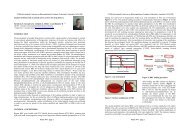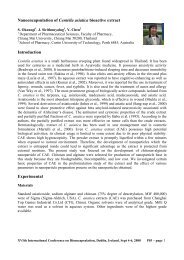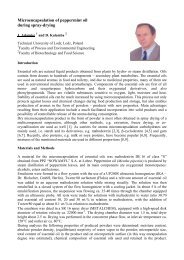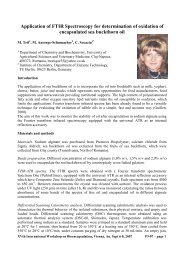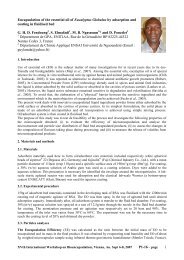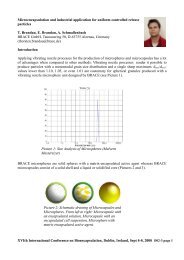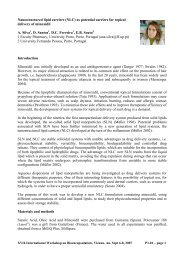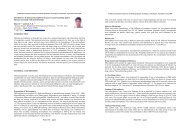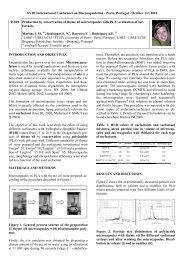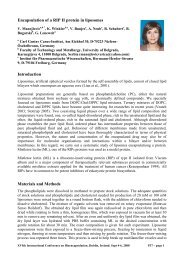Bioencapsulation of Curcuma aromatica extract in solid lipid ...
Bioencapsulation of Curcuma aromatica extract in solid lipid ...
Bioencapsulation of Curcuma aromatica extract in solid lipid ...
You also want an ePaper? Increase the reach of your titles
YUMPU automatically turns print PDFs into web optimized ePapers that Google loves.
XVIIth International Conference on <strong>Bioencapsulation</strong>, Gron<strong>in</strong>gen, Netherlands ; September 24-26, 2009<br />
XVIIth International Conference on <strong>Bioencapsulation</strong>, Gron<strong>in</strong>gen, Netherlands ; September 24-26, 2009<br />
theSLNs could enhance their stability <strong>in</strong> both SLNs and <strong>in</strong> cream formulation significantly. Similar<br />
observation was revealed when the demethoxycurcum<strong>in</strong> contents were determ<strong>in</strong>ed (Fig 5 and 6).<br />
Fig.1. Chromatogram <strong>of</strong> curcum<strong>in</strong>oids<br />
from C. <strong>aromatica</strong>.<br />
Fig.2. Chromatogram <strong>of</strong> standard<br />
curcum<strong>in</strong>oids (Fluka)<br />
Preparation <strong>of</strong> C. <strong>aromatica</strong> loades SLNs and Entrapment efficiency (%EE) : C. <strong>aromatica</strong><br />
loaded SLNs were successfully prepared by high pressure homogenization technique. Firstly,<br />
C.<strong>aromatica</strong> <strong>extract</strong> was dispersed homogeneously <strong>in</strong> a melted <strong>lipid</strong> phase. High speed stirr<strong>in</strong>g was<br />
performed to obta<strong>in</strong> a pre-emulsion, which was subsequently dispersed <strong>in</strong> cold water prior to<br />
pass<strong>in</strong>g to a high pressure homogenizer. In order to select a suitable <strong>lipid</strong> for load<strong>in</strong>g the<br />
C.<strong>aromatica</strong> <strong>extract</strong> <strong>in</strong>to the SLNs, several <strong>lipid</strong>s such as palmitic acid, cetyl palmitate, cetyl<br />
alcohol and stearyl alcohol were employed at different ratios. The most suitable nanoparticles were<br />
derived from palmitic acid and stearyl alcohol mixture with appropriate amount <strong>of</strong> surfactants. The<br />
suspension <strong>of</strong> the prepared nanoparticles was concentrated by centrifugation. Then, the <strong>extract</strong><br />
loaded SLNs were added <strong>in</strong> a model cream base. Transmission electron micrographs (TEM)<br />
revealed that the shape <strong>of</strong> the C.<strong>aromatica</strong> <strong>extract</strong> unloaded and loaded SLNs were a spherical <strong>in</strong><br />
shape. (Fig. 3 and 4). The means particle size <strong>of</strong> them were 236.8 ± 2.8 and 353.8 ± 7.6 and the<br />
polydispersity <strong>in</strong>dex were 0.25 ± 0.01 and 0.29 ± 0.04, respectively. The %EE was measured by<br />
HPLC. The C.<strong>aromatica</strong> <strong>extract</strong> loaded SLNs were found to have the %EE <strong>of</strong> curcum<strong>in</strong>,<br />
demethoxycurcum<strong>in</strong>, and bisdemethoxycurcum<strong>in</strong> <strong>of</strong> 52.2%, 44.5%, and 37.0%, respectively.<br />
125<br />
100<br />
75<br />
%Rema<strong>in</strong><strong>in</strong>g<br />
50<br />
25<br />
0<br />
0 60 120 180 240 300 360 420 480<br />
Time (m<strong>in</strong>)<br />
WC1cr<br />
SLNWC1cr<br />
Fig.5 Influence <strong>of</strong> light on curcum<strong>in</strong> and<br />
SLN loaded curcum<strong>in</strong> <strong>in</strong> cream<br />
CONCLUSION<br />
125<br />
100<br />
75<br />
50<br />
%Rema<strong>in</strong><strong>in</strong>g<br />
25<br />
0<br />
0 60 120 180 240 300 360 420 480<br />
WC2cr<br />
Time (m<strong>in</strong>)<br />
SLNWC2cr<br />
F i g . 6 I n f l u e n c e o f l i g h t o n<br />
demethoxycurcum<strong>in</strong> and SLN loaded<br />
demethoxycurcum<strong>in</strong> <strong>in</strong> cream<br />
The stability <strong>of</strong> curcum<strong>in</strong>oids was successfully improved by prepar<strong>in</strong>g <strong>in</strong> the form <strong>of</strong> SLN. The<br />
stability was <strong>in</strong>creased <strong>in</strong> both free SLN and SLN <strong>in</strong> cream. Suitable comb<strong>in</strong>ation <strong>of</strong> <strong>lipid</strong>s and<br />
surfactants for the preparation <strong>of</strong> SLN is the key factors for the stable SLNs with appropriate size<br />
and size distribution. This SLNs technique yielded mean particle size <strong>of</strong> <strong>Curcuma</strong> <strong>aromatica</strong> loaded<br />
SLNs <strong>of</strong> 353 nm with sufficiently high % entrapment efficiency.<br />
BIBLIOGRAPHY<br />
Fig.3 TEM photograph <strong>of</strong> unloaded <strong>solid</strong><br />
<strong>lipid</strong> nanoparticles (60,000!)<br />
Fig.4 TEM photograph <strong>of</strong> curcum<strong>in</strong>oids<br />
loaded <strong>solid</strong> <strong>lipid</strong> nanoparticles (60,000!)<br />
Photostability <strong>of</strong> curcum<strong>in</strong>oids loaded SLNs : After an exposure <strong>of</strong> the fluorescent light for 8<br />
hours, the stability <strong>of</strong> curcum<strong>in</strong> and demethoxycurcum<strong>in</strong> SLN was monitored at predeterm<strong>in</strong>ed<br />
time-<strong>in</strong>tervals. Greater stability <strong>of</strong> the curcum<strong>in</strong>oids <strong>in</strong> SLN was observed <strong>in</strong> both SLNs and SLNs<br />
<strong>in</strong> cream. At 8 hours, curcum<strong>in</strong> <strong>extract</strong> (WC1) rema<strong>in</strong>ed 58.91%, curcum<strong>in</strong> <strong>in</strong> SLNs (SLNWC1)<br />
rema<strong>in</strong>ed 74.27%, curcum<strong>in</strong> <strong>in</strong> cream (WC1cr) rema<strong>in</strong>ed 74.29% and the curcum<strong>in</strong> SLN <strong>in</strong> cream<br />
(SLNWC1cr) rema<strong>in</strong>ed 84.76%. Therefore the preparation <strong>of</strong> the photolabile curcum<strong>in</strong>oids <strong>in</strong><br />
Oral 06-2 – page 3<br />
Ruby, A. J. et al. (1995), Anti-tumor and antioxidant activity <strong>of</strong> natural curcum<strong>in</strong>oids. Cancer Lett.<br />
94, 79-83<br />
TØnnsen, H. H. et al. (1986), Studies on curcum<strong>in</strong> and curcum<strong>in</strong>oids. VIII. Photochemical stability<br />
<strong>of</strong> curcum<strong>in</strong>. Z. Lebensm.-Unters. Forsch. 183, 116-122<br />
Pushpangadan, P. and Atal, C. K. (1984) Ethno-Medico-Botanical Investigation <strong>in</strong> Kerala I. J.<br />
Ethnopharmacol. 11, 59-77<br />
John, D. (1984), One Hundred Useful Raw Drugs <strong>of</strong> the Kani Tribes <strong>of</strong> Trivandrum Forest Division.<br />
Int. J. Crude Drug Res. 22(1), 17-39<br />
Velayudhan, K. C. et al. (1990), J. Econ. Tax. Bot. 14, 579-582<br />
Müller, R. H. et al. (2000) Solid <strong>lipid</strong> nanoparticles (SLN) for controlled drug delivery – a review <strong>of</strong><br />
the state <strong>of</strong> the art. Eur. J. Pharm. Biopharm. 50, 161-178<br />
Oral 06-2 – page 4



